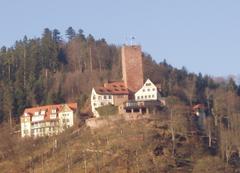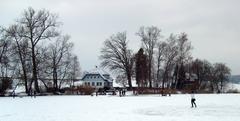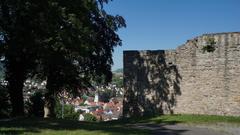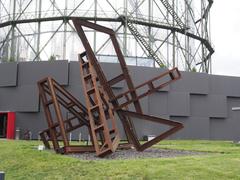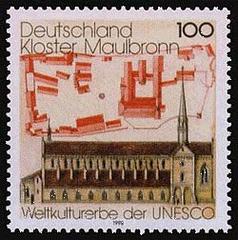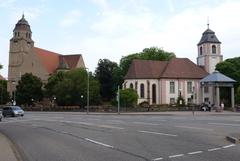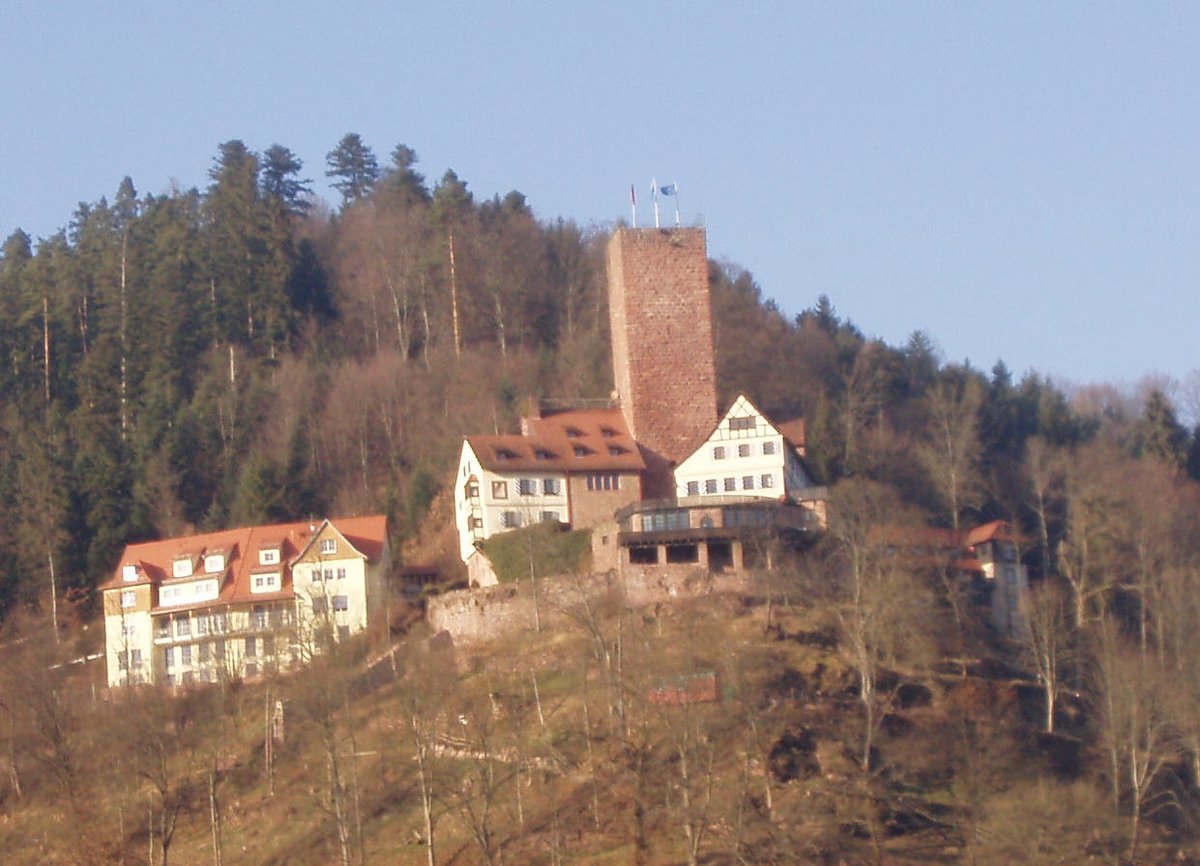
Visiting Burg Liebenzell: History, Tickets, and Tips
Date: 25/07/2024
Introduction
Burg Liebenzell, majestically perched above the town of Bad Liebenzell in the Black Forest region of Germany, stands as a testament to medieval fortification architecture and historical significance. First mentioned in historical records in 1196, the castle was constructed by the Counts of Calw and played a pivotal role in the political landscape of the Holy Roman Empire (Liebenzell Castle). Over the centuries, Burg Liebenzell has witnessed numerous architectural modifications, conflicts, and restoration efforts, reflecting the rich tapestry of European history. Today, the castle is not only a symbol of regional heritage but also a vibrant center for cultural exchange and education, owned and operated by the International Forum of Liebenzell Castle (International Forum of Liebenzell Castle). This comprehensive guide will provide you with all the information needed to visit Burg Liebenzell, including historical insights, visitor information, architectural highlights, and practical tips for an unforgettable experience.
Table of Contents
- Introduction
- History of Burg Liebenzell
- Architectural Highlights
- Visitor Experience and Accessibility
- Practical Tips for Visitors
- Dining and Refreshments
- Souvenirs and Shopping
- Nearby Attractions
- Conclusion
- References
History of Burg Liebenzell
Origins and Early History
Burg Liebenzell was first mentioned in historical records in 1196. Built by the Counts of Calw, the castle played an essential role in the political landscape of the Holy Roman Empire during the Middle Ages. Overlooking the Nagold River valley, its strategic location allowed control over the surrounding area and protection of vital trade routes.
Architectural Evolution
Initially a simple fortification, the castle evolved over centuries. The 13th century saw the addition of a keep, residential buildings, and defensive walls, reflecting typical medieval architecture. Further fortifications in the 15th century included bastions to withstand advanced siege warfare. Although partially destroyed during the Thirty Years’ War, it was partially restored in the 19th century.
Role in Regional Politics
As the seat of the Counts of Calw, Burg Liebenzell was pivotal in regional politics, serving as an administrative center and military stronghold. The castle’s strategic importance made it a focal point of conflict among noble families and territorial states during the late Middle Ages.
Decline and Restoration
Following its partial destruction in the Thirty Years’ War, the castle’s military significance waned, leading to its abandonment by the 18th century. However, the 19th-century interest in medieval architecture spurred efforts to restore Burg Liebenzell, leading to its recognition as a historical landmark.
Cultural Significance
Burg Liebenzell is a cultural icon, inspiring numerous legends, including the tale of the knights and their heroic deeds. Today, it serves as a venue for education and cultural exchange, promoting historical awareness and community engagement.
Architectural Highlights
Historical Construction and Layout
Burg Liebenzell, a hill castle constructed in the 12th century by the Counts of Calw, exemplifies medieval fortification architecture. Its strategic location on a sloping hill spur provided natural defensive advantages, complemented by its robust construction (Liebenzell Castle). The layout includes a central keep, a shield wall, and various ancillary buildings. The main tower, standing at 34 meters, served as both a lookout and a last line of defense. The shield wall protected the castle from direct assaults (International Forum of Liebenzell Castle).
Gothic and Medieval Influences
The castle’s Gothic architectural style features pointed arches, ribbed vaults, and flying buttresses. The St. Blasius Protestant Church, built around the 1490s within the castle grounds, showcases intricate stone carvings, stained glass windows, and a vaulted ceiling. Its robust construction, thick stone walls, narrow windows, and fortified gates reflect its medieval origins and defensive purpose (MyGermanCity).
Modern Adaptations and Uses
Today, Burg Liebenzell is a multifaceted site blending historical significance with modern functionality. Owned by the International Forum of Liebenzell Castle, it serves as a youth training center. Modern adaptations include conference rooms, dormitories, and educational facilities, all designed to complement the medieval architecture (International Forum of Liebenzell Castle). The castle tower, open to the public from 9:00 a.m. to 6:00 p.m., offers panoramic views of the Black Forest. Note that the tower is closed during winter months and inclement weather for safety reasons (Schwarzwald Tourismus).
Visitor Experience and Accessibility
Opening Hours and Admission
The castle is open to visitors from April to October, with daily operating hours typically from 10:00 a.m. to 5:00 p.m. It is advisable to check the official Burg Liebenzell website for the most current information on visiting hours and any special events that might affect accessibility. Admission fees are modest, with discounts available for children, students, and seniors. Group tours can be arranged in advance, offering a more in-depth exploration of the castle’s history and architecture.
Guided Tours and Educational Programs
Guided tours are highly recommended for those interested in the rich history and architectural details of Burg Liebenzell. These tours are available in both German and English and typically last about an hour. Knowledgeable guides provide fascinating insights into the castle’s medieval origins, its role in regional conflicts, and its restoration efforts. For younger visitors, the castle offers educational programs that include interactive activities and medieval-themed workshops, making it an engaging experience for families.
Events and Activities
Throughout the year, Burg Liebenzell hosts a variety of events that bring the castle’s history to life. Medieval fairs, complete with jousting tournaments, traditional music, and artisan crafts, are particularly popular. The castle also serves as a venue for concerts, theater performances, and seasonal festivals. One of the highlights is the annual “Knight’s Feast,” where visitors can enjoy a medieval banquet with period-appropriate food and entertainment. For those interested in more active pursuits, the surrounding area offers numerous hiking and biking trails, providing opportunities to explore the natural beauty of the Black Forest.
Practical Tips for Visitors
Weather
The weather in the Black Forest can be unpredictable, so it’s advisable to dress in layers and bring a raincoat or umbrella, especially if you plan to explore the outdoor areas of the castle.
Footwear
Comfortable walking shoes are a must, as the castle grounds include uneven terrain and steep pathways.
Photography
Photography is allowed in most areas of the castle, but be sure to check for any restrictions, particularly in the museum and chapel.
Language
While many staff members speak English, learning a few basic German phrases can enhance your experience and help with interactions in the local community.
Safety
The castle is well-maintained, but visitors should exercise caution when exploring the higher and more rugged areas, particularly if traveling with young children.
Dining and Refreshments
The castle grounds include a charming café where visitors can relax and enjoy light refreshments. The menu features a selection of local specialties, including Black Forest ham, sausages, and pastries. For a more substantial meal, the town of Bad Liebenzell offers a variety of dining options, ranging from traditional German cuisine to international fare. Many restaurants in the area pride themselves on using locally sourced ingredients, ensuring a fresh and authentic culinary experience.
Souvenirs and Shopping
No visit to Burg Liebenzell would be complete without picking up a souvenir to remember your trip. The castle’s gift shop offers a range of items, including medieval-themed toys, books, and locally made crafts. Visitors can also purchase replicas of historical artifacts and traditional Black Forest products, such as cuckoo clocks and hand-carved wooden figures. For those interested in more extensive shopping, the nearby town of Pforzheim is known for its jewelry and watchmaking industry, offering a wide array of high-quality products.
Nearby Attractions
While Burg Liebenzell is a highlight in itself, the surrounding region offers numerous attractions worth exploring. The town of Bad Liebenzell is known for its thermal baths and wellness centers, providing a perfect way to relax after a day of sightseeing. The nearby Hirsau Monastery, with its impressive ruins and serene setting, is another must-visit. For nature enthusiasts, the Black Forest National Park offers a wealth of outdoor activities, from hiking and mountain biking to wildlife watching and guided nature tours.
Conclusion
Burg Liebenzell offers a unique blend of history, architecture, and cultural significance, making it a must-visit destination in the Black Forest region. From its strategic medieval origins to its modern adaptations, the castle provides a rich educational experience for visitors of all ages. The guided tours and educational programs offer deep insights into the castle’s storied past, while the events and activities bring its history to life. Practical tips and comprehensive visitor information ensure a smooth and enjoyable visit. Whether you are a history enthusiast, a family looking for an educational outing, or someone seeking the natural beauty of the Black Forest, Burg Liebenzell promises a memorable experience. Plan your visit today to immerse yourself in the historical ambiance of this remarkable site (Schwarzwald Tourismus).
References
- Liebenzell Castle, n.d., Wikipedia Liebenzell Castle
- Castle and Tower, n.d., International Forum of Liebenzell Castle International Forum of Liebenzell Castle
- Burg Liebenzell, n.d., Schwarzwald Tourismus Schwarzwald Tourismus
- Bad Liebenzell, n.d., MyGermanCity MyGermanCity
- Liebenzell Castle, n.d., Spotting History Spotting History
